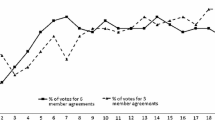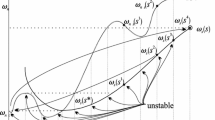Abstract
As an alternative to the environmental cartel approach, we assume that an international environmental agreement aims simply at providing a collective response to a perceived threat. Given this less demanding concept of cooperation and considering that most treaties become enforceable only after ratification by a sufficient number of participants, we examine the set of self-enforceable agreements. This set contains first-best but also second-best agreements that do not maximize the collective welfare of members but meet environmental and/or participative requirements. We study the properties of this set and discuss admissible values of targets and thresholds that favour economics over environmental objectives and vice versa.
Similar content being viewed by others
References
d’Aspremont, C., Jacquemin, A., Gabszewicz, J., & Weymark, J. (1983). On the stability of collusive price leadership. Canadian Journal of Economics, 16, 17–25.
Bade, S., Haeringer, G., & Renou, L. (2009). More strategies, more Nash equilibria. Journal of Economic Theory, 144, 1817–1831.
Bagnoli, M., & Lipman, B. L. (1989). Provision of public goods: fully implementing the core through private contributions. Review of Economic Studies, 56, 583–601.
Bagnoli, M., & Lipman, B. L. (1992). Private provision of public goods can be efficient. Public Choice, 74, 59–78.
Barrett, S. (1994). Self-enforcing international environmental agreements. Oxford Economic Papers, 46, 878–894.
Barrett, S. (2002). Consensus treaties. Journal of Institutional and Theoretical Economics, 158, 529–547.
Barrett, S. (2003). Environment and statecraft: the strategy of environmental treaty making. New York: Oxford University Press.
Barrett, S. (2007). Why cooperate? The incentive to supply global public goods. Oxford: Oxford University Press.
Benedick, R. E. (1998). Ozone diplomacy: new directions in safeguarding the planet (2nd edn.) Cambridge: Harvard University Press.
Black, J., Levi, M. D., & de Meza, D. (1993). Creating a good atmosphere: minimum participation for tackling the greenhouse effect. Economica, 60, 281–293.
Böhringer, C., & Vogt, C. (2004). The dismantling of breakthrough: The Kyoto protocol as symbolic policy. European Journal of Political Economy, 20, 597–618.
Caparros, A., Péreau, J. C., & Tazdaït, T. (2004). North-South climate change negotiations: a sequential game with asymmetric information. Public Choice, 121, 455–480.
Carraro, C., & Siniscalco, D. (1993). Strategies for the international protection of the environment. Journal of Public Economics, 52, 309–328.
Carraro, C., Marchiori, C., & Oreffice, S. (2009). Endogenous minimum participation in international environmental treaties. Environmental & Resource Economics, 42, 411–425.
Cornes, R., & Sandler, T. (1996). The theory of externalities, public goods, and club goods (2nd ed.). Cambridge: Cambridge Univ. Press.
Currarini, S., & Tulkens, H. (2004). Stable international agreements on transfontier pollution with ratification constraints. In C. Carraro & V. Fragnelli (Eds.), Game practice and the environment (pp. 9–36). Cheltenham: Edward Elgar Publishing
Diamantoudi, E., & Sartzetakis, E. (2006). Stable international environmental agreements: an analytical approach. Journal of Public Economic Theory, 8(2), 247–263.
Dietrich, W. F. (1995). The challenge of selecting environmental policy goals: case studies regarding the use of critical levels, CSIA Discussion Paper 95-05, Kennedy School of Government, Harvard University.
Dixit, A., & Olson, M. (2000). Does voluntary participation undermine the Coase theorem? Journal of Public Economics, 76(3), 309–335.
Finus, M. (2001). Game theory and international environmental cooperation. Cheltenham: Edward Elgar.
Finus, M. (2008). Game theoretic research on the design of international environmental agreements: insights, critical remarks and future challenges. International Review of Environmental and Resource Economics, 2, 1–39.
Finus, M., & Maus, S. (2008). Modesty may pay! Journal of Public Economic Theory, 10(5), 801–826.
Frey, B. S. (1997). The public choice of international organizations. In D. Mueller (Ed.), Perspectives on public choice (pp. 106–123). Cambridge: Cambridge University Press.
Grubb, M., Vrolijk, C., & Brack, D. (1999). The Kyoto Protocol, a guide and assessment. London: Royal Institute of International Affairs.
Harstad, B. (2006). Flexible integration? Mandatory and minimum participation rules. The Scandinavian Journal of Economics, 108(4), 683–702.
Hoel, M. (1992). International environment conventions: the case of uniform reductions of emissions. Environmental & Resource Economics, 2, 141–159.
Kohnz, S. (2005). Ratification quotas in international contracts: an example of emission reduction. Mimeo, Yale University.
McBride, M. (2006). Discrete public goods under threshold uncertainty. Journal of Public Economics, 90(6–7), 1181–1199.
Nitzan, S., & Romano, R. (1990). Private provision of a discrete public good with uncertain cost. Journal of Public Economics, 42, 357–370.
Nordhaus, W. (2007). The challenge of global warming, economics model and environmental policy in the DICE 2007 Model. Mimeo, Yale University.
Okada, O. (1993). The possibility of cooperation in an n-person Prisoners’ dilemma with institutional arrangements. Public Choice, 77(3), 629–656.
Palfrey, T., & Rosenthal, H. (1984). Participation and the provision of discrete public goods: a strategic analysis. Journal of Public Economics, 24, 171–193.
Patt, A. (1999). Separating analysis from politics: acid rain in Europe. Review of Policy Research, 16(34), 104–137.
Rutz, S. (2002). International environmental agreements: much ado about nothing? Ph.D thesis. Aachen: Shaker Verlag.
Sandler, T., & Hartley, K. (2001). Economics of alliances: the lessons for collective action. Journal of Economic Literature, 39, 869–896.
Suleiman, R. (1997). Provision of step-level public goods under uncertainty: a theoretical analysis. Rationality and Society, 9, 163–187.
Vaubel, R. (1986). A public choice approach to international organization. Public Choice, 51, 39–58.
Vaubel, R., Dreher, A., & Soylu, U. (2007). Staff growth in international organizations: a principal-agent problem? An empirical analysis. Public Choice, 133, 275–295.
Weikard, H. P., Wangler, L., & Freytag, A. (2009). Minimum participation rules with heterogeneous countries. Jena Economic Research Papers in Economics 2009-077.
Author information
Authors and Affiliations
Corresponding author
Additional information
An erratum to this article can be found at http://dx.doi.org/10.1007/s11127-012-9918-z.
Rights and permissions
About this article
Cite this article
Courtois, P., Haeringer, G. Environmental cooperation: ratifying second-best agreements. Public Choice 151, 565–584 (2012). https://doi.org/10.1007/s11127-010-9759-6
Received:
Accepted:
Published:
Issue Date:
DOI: https://doi.org/10.1007/s11127-010-9759-6




